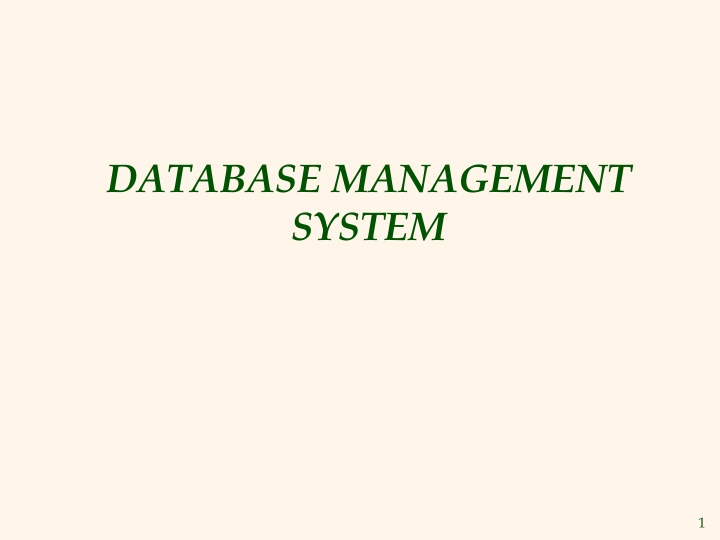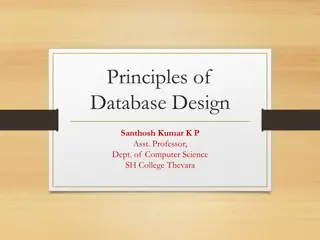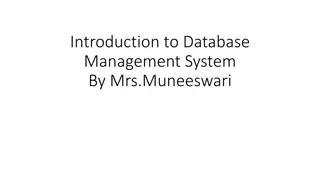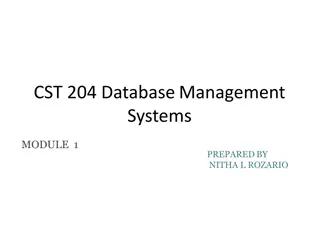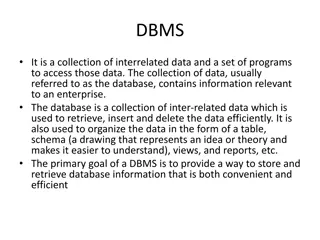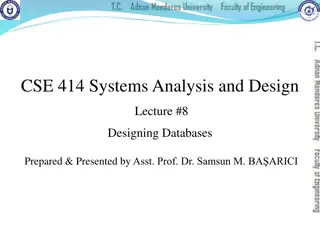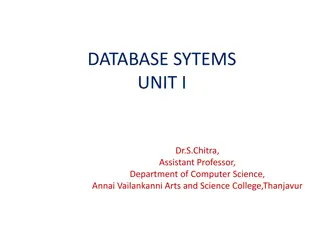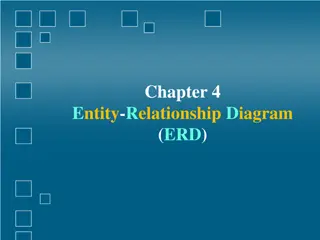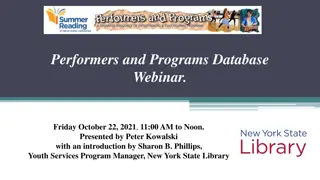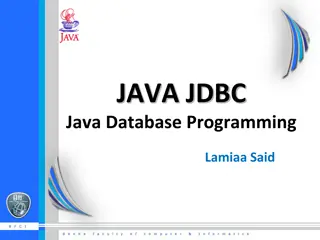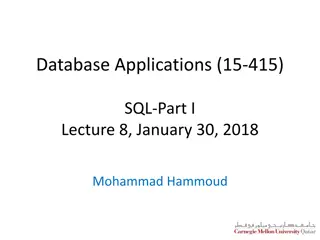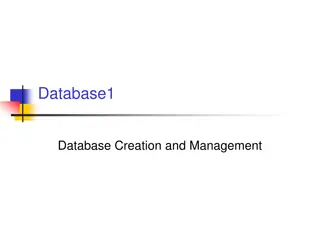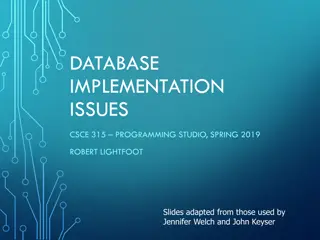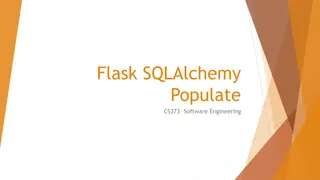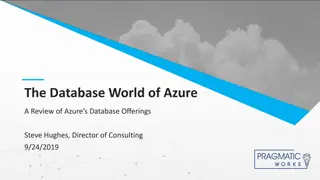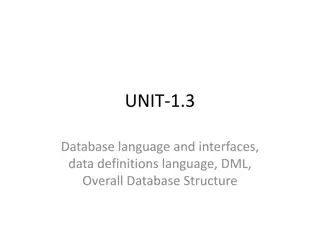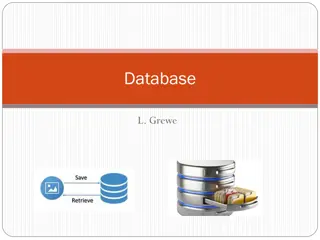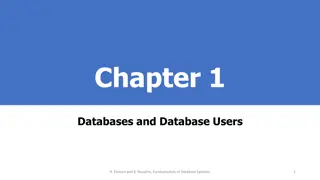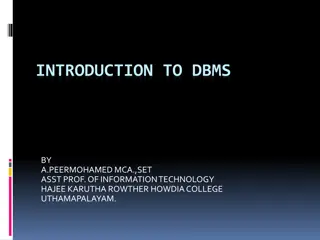Overview of Database Management Systems
This content provides an overview of database management systems, including basic definitions, the evolution of DB systems, the purpose of database systems, and advantages of the database approach. It also discusses the disadvantages of file processing systems, highlighting issues such as data redundancy, limited data sharing, and vulnerability to inconsistency. The evolution of DB systems from flat files to web-enabled systems is outlined, showcasing the advancements in data management over the years.
Download Presentation

Please find below an Image/Link to download the presentation.
The content on the website is provided AS IS for your information and personal use only. It may not be sold, licensed, or shared on other websites without obtaining consent from the author.If you encounter any issues during the download, it is possible that the publisher has removed the file from their server.
You are allowed to download the files provided on this website for personal or commercial use, subject to the condition that they are used lawfully. All files are the property of their respective owners.
The content on the website is provided AS IS for your information and personal use only. It may not be sold, licensed, or shared on other websites without obtaining consent from the author.
E N D
Presentation Transcript
DATABASE MANAGEMENT SYSTEM 1
Basic Definitions Database: A logical coherent collection of data representing the mini-world such that change in the mini-world brings about change in database collected for a particular purpose and for a group of intended users. Data: Meaningful facts, text, graphics, images, sound, video segments that can be recorded and have an implicit meaning. Metadata: Data that describes data File Processing System A collection of application programs that perform services for the end-users such as production of reports Each program defines and manages its own data Database Management System (DBMS): A software package/ system to facilitate the creation and maintenance of a computerized database. Database System: The DBMS software together with the data itself. Sometimes, the applications are also included. Database + DBMS 2
Simplified database system environment 3
Evolution of DB Systems Flat files - 1960s - 1980s Hierarchical 1970s - 1990s Network 1970s - 1990s Relational 1980s - present Object-oriented 1990s - present Object-relational 1990s - present Data warehousing 1980s - present Web-enabled 1990s - present 4
Purpose of Database Systems Database management systems were developed to handle the difficulties of typical file-processing systems supported by conventional operating systems 5
Disadvantages of File Processing Program-Data Dependence File structure is defined in the program code. All programs maintain metadata for each file they use Duplication of Data (Data Redundancy) Different systems/programs have separate copies of the same data Same data is held by different programs. Wasted space and potentially different values and/or different formats for the same item. Limited Data Sharing No centralized control of data Programs are written in different languages, and so cannot easily access each other s files. Lengthy Development Times Programmers must design their own file formats Excessive Program Maintenance 80% of of information systems budget Vulnerable to Inconsistency Change in one table need changes in corresponding tables as well otherwise data will be inconsistent 6
Advantages of Database Approach Data independence and efficient access. Data integrity and security. Uniform data administration. Concurrent access, recovery from crashes. Replication control Reduced application development time. Improved Data Sharing Different users get different views of the data Enforcement of Standards All data access is done in the same way Improved Data Quality Constraints, data validation rules Better Data Accessibility/ Responsiveness Use of standard data query language (SQL) Security, Backup/Recovery, Concurrency Disaster recovery is easier 7
Costs and Risks of the Database Approach Up-front costs: Installation Management Cost and Complexity Conversion Costs Ongoing Costs Requires New, Specialized Personnel Need for Explicit Backup and Recovery Organizational Conflict Old habits die hard 8
Database Applications Database Applications: Banking: all transactions Airlines: reservations, schedules Universities: registration, grades Sales: customers, products, purchases Manufacturing: production, inventory, orders, supply chain Human resources: employee records, salaries, tax deductions Databases touch all aspects of our lives 9
Levels of Abstraction Many views, single conceptual (logical) schema and physical schema. Views describe how users see the data. Conceptual schema defines logical structure Physical schema describes the files and indexes used. View 1 View 2 View 3 Conceptual Schema Physical Schema * Schemas are defined using DDL; data is modified/queried using DML. 10
Example: University Database Conceptual schema: Students(sid: string, name: string, login: string, age: integer, gpa:real) Courses(cid: string, cname:string, credits:integer) Enrolled(sid:string, cid:string, grade:string) Physical schema: Relations stored as unordered files. Index on first column of Students. External Schema (View): Course_info(cid:string, enrollment:integer) 11
Instances and Schemas Similar to types and variables in programming languages Schema the logical structure of the database (e.g., set of customers and accounts and the relationship between them) Instance the actual content of the database at a particular point in time 12
Data Independence Ability to modify a schema definition in one level without affecting a schema definition in the other levels. The interfaces between the various levels and components should be well defined so that changes in some parts do not seriously influence others. Two levels of data independence Physical data independence:- Protection from changes in logical structure of data. Logical data independence:- Protection from changes in physical structure of data. 13
Instances and Schemas Similar to types and variables in programming languages Schema the logical structure of the database e.g., the database consists of information about a set of customers and accounts and the relationship between them) Analogous to type information of a variable in a program Physical schema: database design at the physical level Logical schema: database design at the logical level Instance the actual content of the database at a particular point in time Analogous to the value of a variable Physical Data Independence the ability to modify the physical schema without changing the logical schema Applications depend on the logical schema In general, the interfaces between the various levels and components should be well defined so that changes in some parts do not seriously influence others. 14
Database Languages Data Definition Language (DDL) Specification notation for defining the database schema DDL compiler generates a set of tables stored in a data dictionary Data dictionary contains metadata (data about data) Data storage and definition language special type of DDL in which the storage structure and access methods used by the database system are specified Data Manipulation Language(DML) Language for accessing and manipulating the data organized by the appropriate data model Two classes of languages Procedural user specifies what data is required and how to get those data Nonprocedural user specifies what data is required without specifying how to get those data 15
Database Users Users are differentiated by the way they expect to interact with the system Application programmers interact with system through DML calls Sophisticated users form requests in a database query language Specialized users write specialized database applications that do not fit into the traditional data processing framework Na ve users invoke one of the permanent application programs that have been written previously E.g. people accessing database over the web, bank tellers, clerical staff 16
Database Administrator Coordinates all the activities of the database system; the database administrator has a good understanding of the enterprise s information resources and needs. Database administrator's duties include: Schema definition Storage structure and access method definition Schema and physical organization modification Granting user authority to access the database Specifying integrity constraints Acting as liaison with users Monitoring performance and responding to changes in requirements 17
Data Models A collection of tools for describing: Data Data relationships Data semantics Data constraints Object-based logical models Entity-relationship model Object-oriented model Semantic model Functional model Record-based logical models Relational model (e.g., SQL/DS, DB2) Network model Hierarchical model (e.g., IMS) 18
Entity-Relationship Model The basics of Entity-Relationship modelling u Entities (objects) E.g. customers, accounts, bank branch u Attributes u Relationships between entities E.g. Account A-101 is held by customer Johnson Relationship set depositor associates customers with accounts Widely used for database design Database design in E-R model usually converted to design in the relational model which is used for storage and processing 19
name ER Model Basics ssn lot Employees Entity: Real-world object distinguishable from other objects. An entity is described using a set of attributes. Each attribute has a domain. Entity Set: A collection of similar entities. E.g., all employees. All entities in an entity set have the same set of attributes. (Until we consider ISA hierarchies, anyway!) Each entity set has a key. Weak Entities: A weak entity can be identified uniquely only by considering the primary key of another (owner) entity. 20
name ER Model Basics ssn lot Employees since name dname super- visor subor- dinate ssn budget lot did Reports_To Works_In Employees Departments Relationship: Association among two or more entities. E.g., Attishoo works in Pharmacy department. Relationship Set: Collection of similar relationships. An n-ary relationship set R relates n entity sets E1 ... En; each relationship in R involves entities e1 E1, ..., en En Same entity set could participate in different relationship sets, or in different roles in same set. 21
E-R Diagrams Rectangles represent entity sets. Diamonds represent relationship sets. Lines link attributes to entity sets and entity sets to relationship sets. Ellipses represent attributes Double ellipses represent multivalued attributes. Dashed ellipses denote derived attributes. Underline indicates primary key attributes (will study later) n n n n l l n 22
Mapping Cardinality Constraints Express the number of entities to which another entity can be associated via a relationship set. Most useful in describing binary relationship sets. For a binary relationship set the mapping cardinality must be one of the following types: One to one One to many Many to one Many to many 23
Mapping Cardinalities One to one One to many Many to one Many to many 24
Participation Constraints Does every department have a manager? If so, this is a participation constraint: the participation of Departments in Manages is said to be total (vs. partial). Every Department entity must appear in an instance of the relationship Works_In (have an employee) and every Employee must be in a Department Both Employees and Departments participate totally in Works_In name name dname dname since ssn did did budget budget lot Departments Employees Manages Works_In since 25
Keys A super key of an entity set is a set of one or more attributes whose values uniquely determine each entity. A candidate key of an entity set is a minimal super key Customer_id is candidate key of customer account_number is candidate key of account Although several candidate keys may exist, one of the candidate keys is selected to be the primary key. Alternate key is the candidate key which are not selected as primary key. Foreign key are the attributes of an entity that points to the primary key of another entity. They act as a cross-reference between entities. Composite Key consists of two or more attributes that uniquely identify an entity. Non-key attributes are the attributes or fields of a table, other than candidate key attributes/fields in a table. Non-prime Attributes are attributes other than Primary Key attribute(s).. 26
Relational Model Example of tabular data in the relational model: name Johnson Smith Johnson Jones Smith ssn street city account-number A-101 A-215 A-201 A-217 A-201 192-83-7465 Alma Palo Alto 019-28-3746 North Rye 192-83-7465 Alma Palo Alto 321-12-3123 Main Harrison 019-28-3746 North Rye account-number balance A-101 A-201 A-215 A-217 500 900 700 750 27
Relational Model (Basic) The relational model used the basic concept of a relation or table. Tuple:- A tuple is a row in a table. Attribute:- An attribute is the named column of a relation. Domain:- A domain is the set of allowable values for one or more attributes. Degree:- The number of columns in a table is called the degree of relation. Cardinality:- The number of rows in a relation,is called the cardinality of the relation. 28
Integrity Constraints Integrity constraints guard against accidental damage to the database, by ensuring that authorized changes to the database do not result in a loss of data consistency. Domain Constraints:- It specifies that the value of each attribute x must be an atomic value from the domain of x. Key Constraints:- Primary Key must have unique value in the relational table. Referential Integrity:-It states that if a foreign key in table A refers to the primary key of table B then, every value of the foreign key in table A must be null or be available in table B. Entity Integrity:- It states that no attribute of a primary key can have a null value. 29
SQL Introduction Standard language for querying and manipulating data Structured Query Language Many standards out there: ANSI SQL, SQL92 (a.k.a. SQL2), SQL99 (a.k.a. SQL3), . Vendors support various subsets: watch for fun discussions in class ! 31
SQL Data Definition Language (DDL) Create/alter/delete tables and their attributes Following lectures... Data Manipulation Language (DML) Query one or more tables discussed next ! Insert/delete/modify tuples in tables 32
Table name Attribute names Tables in SQL Product PName Price Category Manufacturer Gizmo $19.99 Gadgets GizmoWorks Powergizmo $29.99 Gadgets GizmoWorks SingleTouch $149.99 Photography Canon MultiTouch $203.99 Household Hitachi Tuples or rows 33
Tables Explained The schema of a table is the table name and its attributes: Product(PName, Price, Category, Manfacturer) A key is an attribute whose values are unique; we underline a key Product(PName, Price, Category, Manfacturer) 34
Data Types in SQL Atomic types: Characters: CHAR(20), VARCHAR(50) Numbers: INT, BIGINT, SMALLINT, FLOAT Others: MONEY, DATETIME, Every attribute must have an atomic type Hence tables are flat Why ? 35
Tables Explained A tuple = a record Restriction: all attributes are of atomic type A table = a set of tuples Like a list but it is unorderd: no first(), no next(), no last(). 36
SQL Query Basic form: (plus many many more bells and whistles) SELECT <attributes> FROM <one or more relations> WHERE <conditions> 37
Simple SQL Query Product PName Price Category Manufacturer Gizmo $19.99 Gadgets GizmoWorks Powergizmo $29.99 Gadgets GizmoWorks SingleTouch $149.99 Photography Canon MultiTouch $203.99 Household Hitachi SELECT * FROM Product WHERE category= Gadgets PName Price Category Manufacturer Gizmo $19.99 Gadgets GizmoWorks Powergizmo $29.99 Gadgets GizmoWorks selection 38
Simple SQL Query Product PName Price Category Manufacturer Gizmo $19.99 Gadgets GizmoWorks Powergizmo $29.99 Gadgets GizmoWorks SingleTouch $149.99 Photography Canon MultiTouch $203.99 Household Hitachi SELECT PName, Price, Manufacturer FROM Product WHERE Price > 100 PName Price Manufacturer selection and projection SingleTouch $149.99 Canon MultiTouch $203.99 Hitachi 39
Notation Input Schema Product(PName, Price, Category, Manfacturer) SELECT PName, Price, Manufacturer FROM Product WHERE Price > 100 Answer(PName, Price, Manfacturer) Output Schema 40
Keys and Foreign Keys Company CName StockPrice Country GizmoWorks 25 USA Key Canon 65 Japan Hitachi 15 Japan Product PName Gizmo Powergizmo SingleTouch MultiTouch Price $19.99 $29.99 $149.99 $203.99 Category Gadgets Gadgets Photography Household Manufacturer GizmoWorks GizmoWorks Canon Hitachi Foreign key 41
Joins Product (pname, price, category, manufacturer) Company (cname, stockPrice, country) Find all products under $200 manufactured in Japan; return their names and prices. Join between Product and Company SELECT PName, Price FROM Product, Company WHERE Manufacturer=CName AND Country= Japan AND Price <= 200 42
Joins Product Company PName Price Category Manufacturer Cname StockPrice Country Gizmo $19.99 Gadgets GizmoWorks GizmoWorks 25 USA Powergizmo $29.99 Gadgets GizmoWorks Canon 65 Japan SingleTouch $149.99 Photography Canon Hitachi 15 Japan MultiTouch $203.99 Household Hitachi SELECT PName, Price FROM Product, Company WHERE Manufacturer=CName AND Country= Japan AND Price <= 200 PName Price SingleTouch $149.99 43
More Joins Product (pname, price, category, manufacturer) Company (cname, stockPrice, country) Find all Chinese companies that manufacture products both in the electronic and toy categories SELECT cname FROM WHERE 44
NULLS in SQL Whenever we don t have a value, we can put a NULL Can mean many things: Value does not exists Value exists but is unknown Value not applicable Etc. The schema specifies for each attribute if can be null (nullable attribute) or not How does SQL cope with tables that have NULLs ? 45
Outer Joins Left outer join: Include the left tuple even if there s no match Right outer join: Include the right tuple even if there s no match Full outer join: Include the both left and right tuples even if there s no match 46
Modifying the Database Three kinds of modifications Insertions Deletions Updates Sometimes they are all called updates 47
Insertions General form: INSERT INTO R(A1, ., An) VALUES (v1, ., vn) Example: Insert a new purchase to the database: INSERT INTO Purchase(buyer, seller, product, store) VALUES ( Joe , Fred , wakeup-clock-espresso-machine , The Sharper Image ) Missing attribute NULL. May drop attribute names if give them in order. 48
Insertions INSERT INTO PRODUCT(name) SELECT DISTINCT Purchase.product FROM Purchase WHERE Purchase.date > 10/26/01 The query replaces the VALUES keyword. Here we insert many tuples into PRODUCT 49
Insertion: an Example Product(name, listPrice, category) Purchase(prodName, buyerName, price) prodName is foreign key in Product.name Suppose database got corrupted and we need to fix it: Purchase Product prodName buyerName price name listPrice category camera John 200 gizmo Smith 80 gizmo 100 gadgets camera Smith 225 Task: insert in Product all prodNames from Purchase 50
